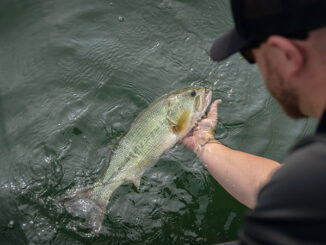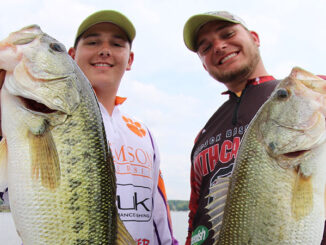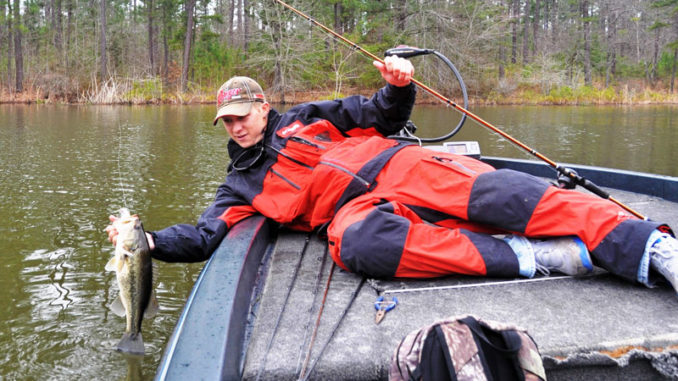
Chatterbaits, aka bladed jigs, are killer lures as bass start to stir this month in North Carolina’s top trophy lake, Shearon Harris.
Each spring, Mother Nature makes her first brush strokes to paint the natural world a color that chases away winter’s brown and gray hues.
Bushes, tree buds, ground cover and grasses become green as longer stretches of daylight activate plant chlorophyll to overwhelm winter’s drab shades.
The season’s first visual change also drops the green flag for anglers, who know it’s time to put the pedal to the metal as the South’s pursuit of bass begins.
Anglers notice how aquatic vegetation respond to the sun’s warmth that also triggers the prespawn feeding urge. When surface plants seems to green-up almost overnight, their attention is triggered.
“It’s the first time every year you really can target shallow fish,” said Josh Hooks, 29, a tournament angler. “It’s especially a good time to be at Harris Lake.”
Shearon Harris, a 4,100-acre Duke Energy lake in Chatham and Wake counties south of Raleigh, N.C., and north of Sanford is a favorite of lunker hunters. The Y-shaped impoundment features a central section with several deep channels plus three major arms containing coves, stump flats, standing timber and, once upon a time, acres of submerged aquatic grasses.
“But it doesn’t have as much elodea, hydrilla and milfoil as it used to,” said Hooks, a former member of N.C. State’s “Basspack” fishing team, who laments the loss of submerged grass because of the baitfish it attracts and the fat largemouths it grows.
“The grass beds are dinner tables for largemouths at any lake,” Hooks said. “The more grass, the more bass. Shad, minnows and fry hide in the stuff. Triangle guys always could identify lakes by bass shapes. The biggest bass, shaped like footballs, usually came from Harris….”
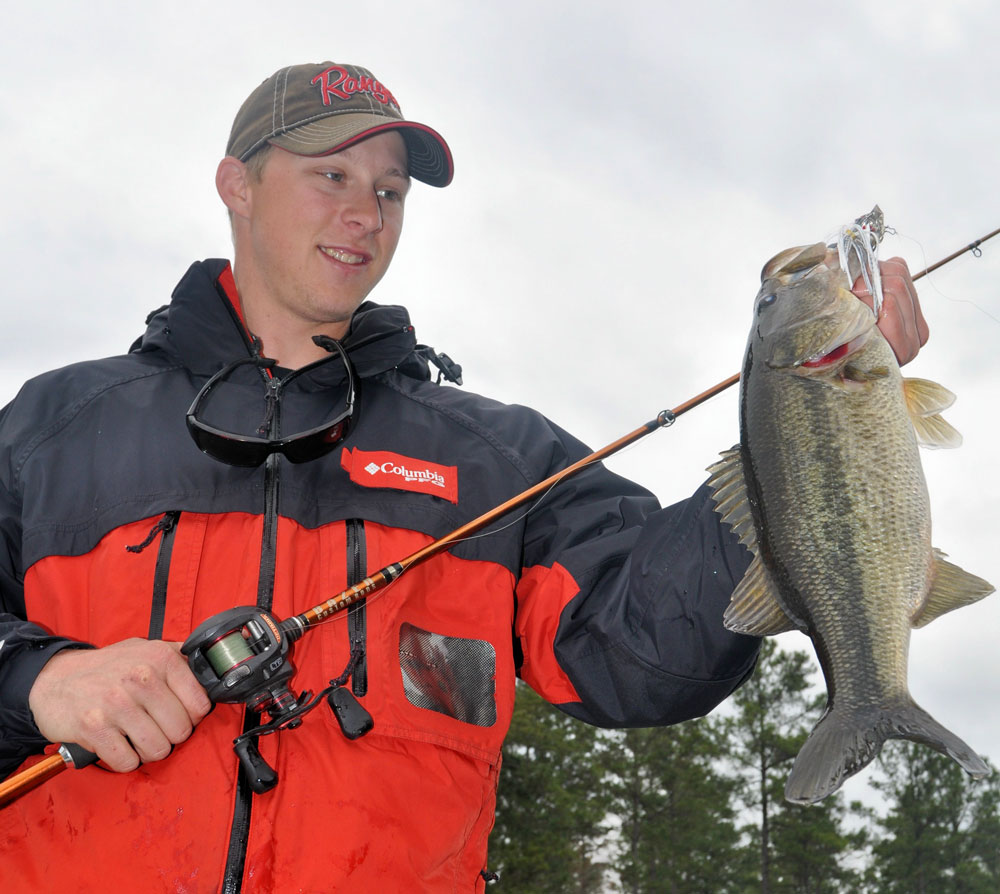
Ten-pounders were common, and Harris even produced a few 12-pounders. In 2003, the N.C. Wildlife Resources Commission helped the lake maintain magnum largemouth numbers with a 16- to 20-inch no-keeper slot rule. It produced the state’s finest trophy-bass fishery.
But by 2013, Duke Energy had released 4,000 diploid (sterile) grass carp into the lake to eat aquatic plants, The company denied spraying herbicide to kill the grass — as plenty of fishermen alleged. The only spraying was an N.C. State University test inside a cove in the late 1990s. When winds spread floating strands of dead hydrilla across the lake, the spraying rumor gained traction, according to biologists with the N.C. Wildlife Resources Commission.
After 2018’s record rainfall, which didn’t allow the lake level to drop, spring fishing in 2019 should be excellent, and Hooks knows how he’ll get started, around the dominant remaining vegetation.
“The first thing guys at Harris should look for is primrose along the shoreline and at backs of coves,” Hooks said. “There won’t be a lot of primrose showing in early spring in coves and shorelines, but you should definitely fish it when you find it. You just need to go look for it.”
Hooks’ favorite lure for late February and March is a Chatterbait, often referred to as a “bladed jig.”
“March is the prime chatterbait time,” he said. “As soon as you start to see primrose in coves, that’s when you need to start throwing a Chatterbait. It just takes a little bit of green to pull bass to places with primrose.”
Later, other lures will come into play, including spinnerbaits, jigs and floating worms.
Primrose, hydrilla, milfoil and elodea fronds grow together with primrose along shorelines on Harris. Other than primrose, the other species are dormant until water temperatures warm. Primrose strands, easily recognized, are green with small yellow five-petal flowers.
“The back of White Oak Creek had primrose in the past, but that’s not a guarantee it’ll always be there,” Hooks said. “You’ve just got to put some time in and look until you find it.”
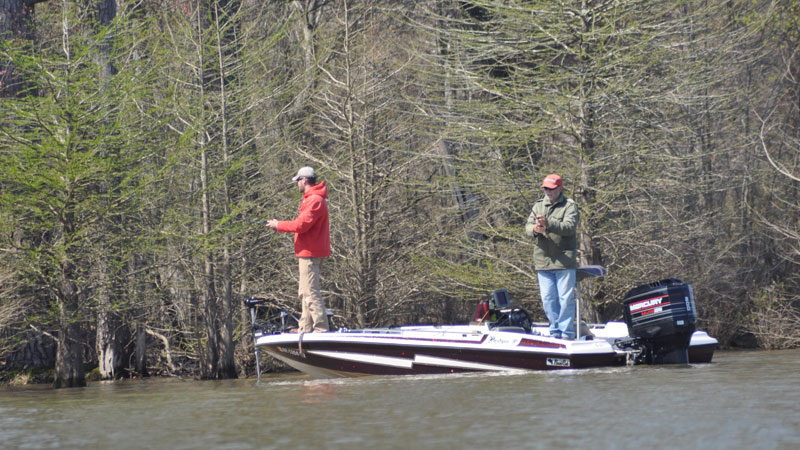
Why do chatterbaits work well near that plant?
“You have to remember bass metabolisms slow down in winter, so when the prespawn time begins, they haven’t eaten in a while, and they’re hungry,” Hooks said. “But they’d rather eat one big baitfish than expend energy chasing several smaller baits, such as (threadfin) shad. It’s like eating a bag of potato chips versus a big, juicy, sirloin steak.”
To a bass, Chatterbaits are like a big piece of steak. First, they’ve got a big profile, like a wounded bream or a big baitfish. They’re noisy, which mimics a wounded baitfish or a bass attacking a baitfish. It’s almost an axiom that bigger baits catch bigger fish, especially during spring.
“The lure’s metal lip also adds some flash when it comes through the water, plus it vibrates,” Hooks said.
Finally, Hooks, a native of nearby New Hill, N.C., who has fished Harris since he was a teen-ager, likes a Chatterbait with a jighead that wobbles from side to side and adds more vibration.
“I like to beef up mine with a big swimbait trailer or a 4- or 4 1/2-inch white spinnerbait trailer on a 3/8-ounce head. It looks like a big baitfish,” he said. “But if they are chasing, they’ll go after just about anything you put in front of them. I still think if you build up a Chatterbait’s profile, you’ll increase your chances of catching bigger fish.”
But the major reason to use a Chatterbait is that it’s 90-percent weedless. Few spring lures can be thrown into vegetation without getting snagged.
“Most lures cast into grass get caught, but not so much a Chatterbait — if you retrieve it correctly,” Hooks said. “It’s really hard to hang up.”
Many anglers who have a lure caught in grass or weeds will jerk the lure, but normally, that only causes more problems. That means a trip into the grass for your trolling motor — smashing into bass dining rooms — a sure way to scatter fish.
The technique to free a snared Chatterbait is the opposite: use a slow, steady retrieve and keep boats out of grass.
“You shouldn’t jerk on a hung-up chatterbait or try to lift it up,” Hooks said. “Just crank the reel handle slow and steady; most of the time, they’ll come through heavy stuff.”
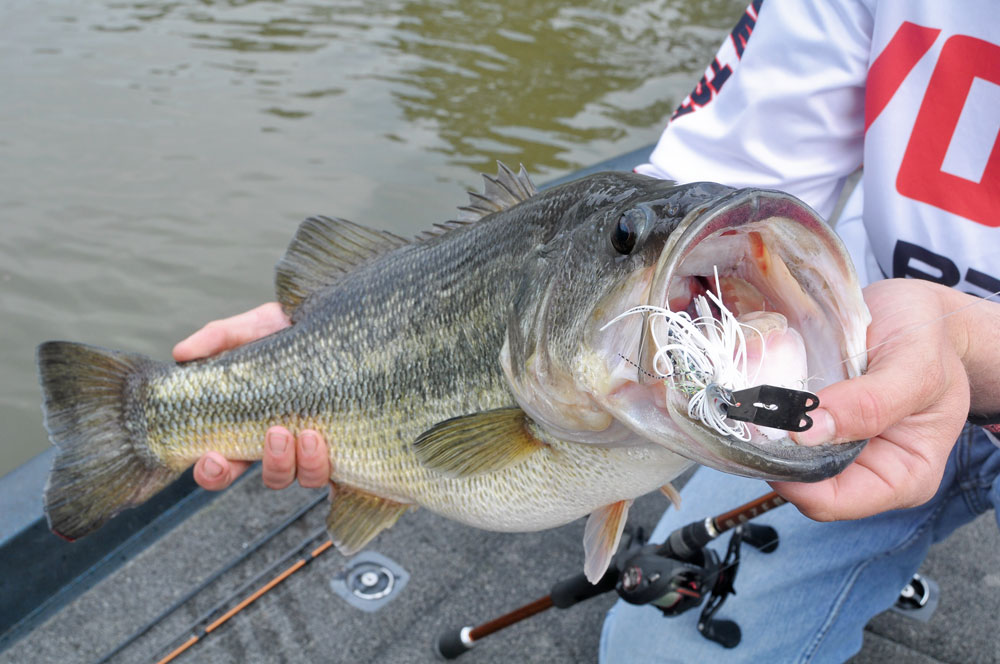
Early in February, Hooks checks the backs of coves along Harris Lake’s northwest shoreline for potential bass habitat with primrose and other spots of green.
“If I can find a corner on a point with primrose, that’s often a staging point for bass” he said. “In past years, I tried a hit-or-miss approach without much success. You could fish same-looking places and not see a fish for miles. I found out there’s usually a reason (bass) are somewhere. It just means you really have to look for keys; you gotta pay attention.”
One of the best February conditions includes a southeast wind during a period of mile weather three to four days or longer. Wind piles up warmer water at the backs or sides of coves and pulls bass toward grass. But Hooks said big females aren’t committed yet to bedding and may relocate to different areas from year to year. Also, because of weather changes and heavy rains, they may often spawn a month later than normal.
“In March sometimes they can be in the backs of coves or halfway back,” he said. “You need to be aware of water temperatures.”
Bass usually become active when the water temperature rises above 50 to 55 degrees, he said. “When it gets to 60 degrees, they look for spawning habitat.”
Before the water gets that warm, he favors throwing a Chatterbait because it allows him to cover more water “and you get reaction strikes.”
“I try to just tick the tips of grass beds,” he said. “If you’re getting bites by small bass, that means big ones are nearby. I fish all the way around grass beds. No matter how small or big, bass usually blast Chatterbaits, too.”
Hooks’ largest Harris lunker — nearly 10 pounds — whacked a chatterbait in early March.
How a Chatterbait works
Every Chatterbait, aka bladed jig, has a oddly shaped metal lip. The front lip, aka flange, has three holes drilled in a row with the top hole a little larger than the other two. The bait’s jighead has an eyelet that goes through the hole on the bottom of the lip, and a cross-lock snap swivel goes through the other two. Both holes are wide enough to allow the bait to wiggle when retrieved.
That certainly doesn’t sound like a weedless bait, but bass pro Josh Hooks understands.
“The lip design and jighead’s weight probably are the keys,” he said.
The metal lip points downward when retrieved, digging toward the bottom like a crankbait. But the jighead, hook and skirt slide through a hole in the water created by the lip, which also prevents a Chatterbait from rolling and turning the hook downward, where it can get snagged.
Simply, the business end of a Chatterbait follows a cleared hole in the water the lip/flange produces as it bounces off submerged aquatic weeds.
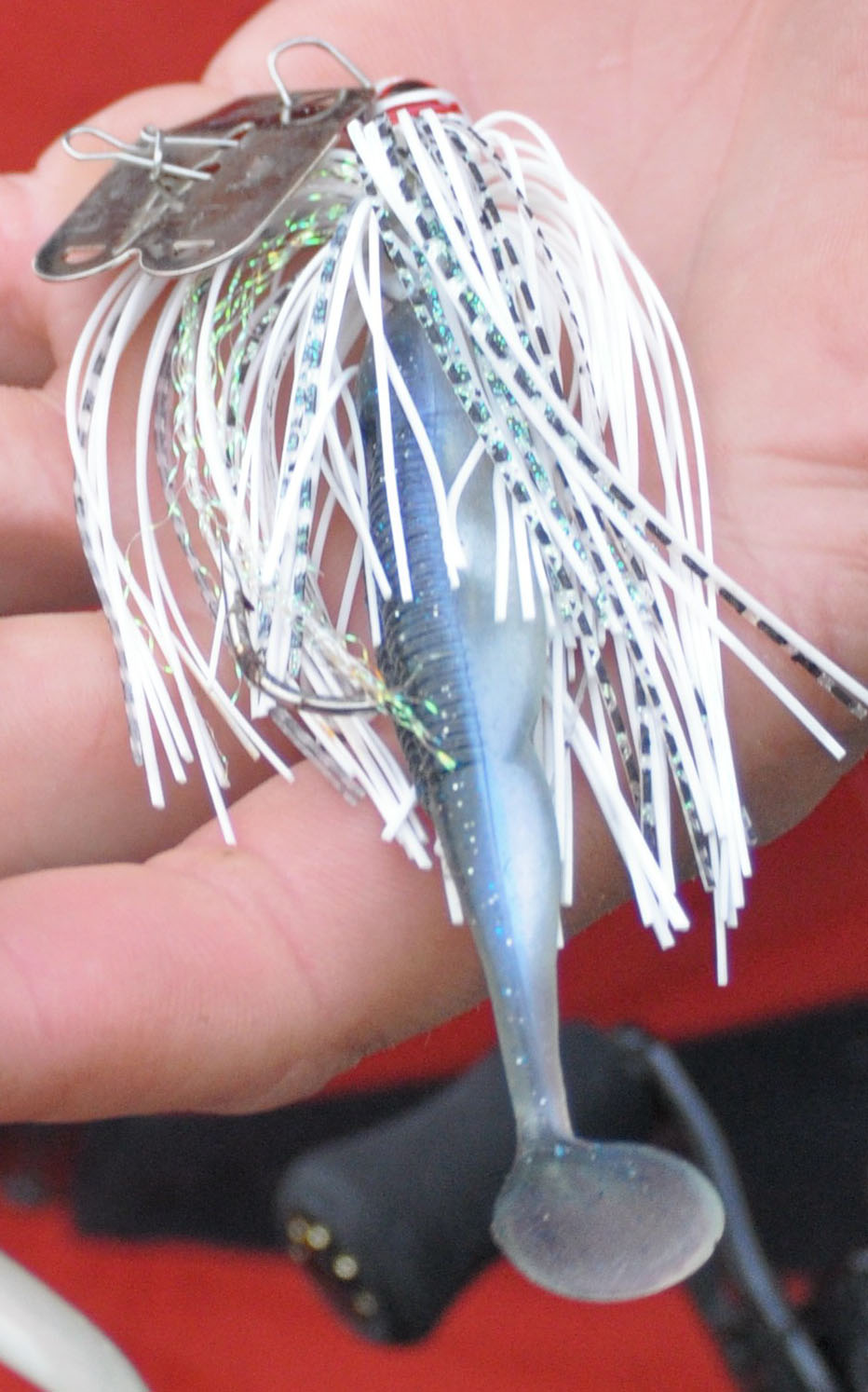
Additionally, Chatterbait lips, made of thin metal, can be bent. The more the bend, the more wiggle the lip creates.
But does one brand work best?
Several companies produce bladed jigs, but the original Chatterbait was invented by Rod Davis of Greenwood, S.C. His company, RAD Lures, produced the first Chatterbaits, then sold out to Z-Man Fishing Products.
Hooks uses a Chatterbait knock-off produced by a long-time fishing buddy from Wake County. That bait features a football-shaped jighead that imparts more movement than factory models.
“It’s my secret weapon for early-spring bass,” he said.
Destination Information
- HOW TO GET THERE — Shearon Harris Lake is off US 1 between Raleigh, N.C., and Sanford, N.C. It is serviced by two public boat ramps, Holleman’s Landing on Holleman Road off Welfare Road from US 1, and Crosspoint on Christian Church Road off NC 42 from US 421.
- WHEN TO GO — Spring bass fishing is excellent from February through April.
- BEST TECHNIQUES — Fish Chatterbaits on medium-action baitcasting outfits across the top of and around submerged vegetation. As March approaches, go with floating worms and weedless frogs or rats. Try coves off the main lake and look for primose flowers and mats at the surface.
- FISHING INFO/GUIDES — Jeff Thomas, 919-770-4654. See also Guides & Charters in Classifieds.
- ACCOMMODATIONS — Hampton Inn & Suites, Holly Springs, N.C., 919-552-7610; Palamino Motel, Sanford, N.C., 919-776-7531; Holiday Inn & Suites, Sanford, N.C., 919-776-6600; Hampton Inn, Sanford, N.C., 919-775-2000; EconoLodge, Sanford, N.C., 919-774-6411; Days Inn, Sanford, N.C., 919-213-7238.
- MAPS — Kingfisher Maps, 800-326-0257, www.kfmaps.com.

